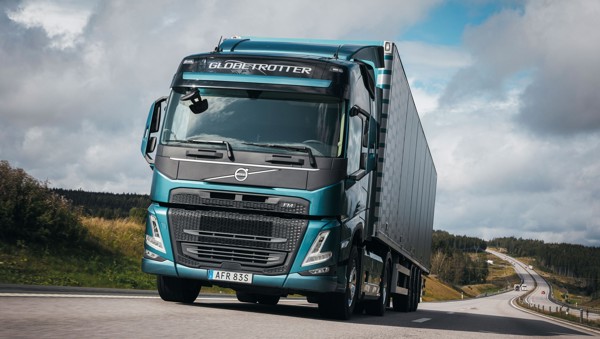Review
Volvo Trucks has taken the bold step of upgrading virtually all its range during 2020 and, while many will naturally focus on the top of range flagship FH16, the workhorse of its tractor range, the FM, shouldn’t get overlooked.
Its UK history with low and high cabs, of course, started with the legendary F86 and F88 models in the ’60s and ’70s and this two-step approach has subsequently been copied by many manufacturers.
The contemporary equivalent of the F86 is the FM range. It’s been a number of years since it attracted the attention of Volvo’s designers and engineers, so UK truck operators will view this latest incarnation as a welcome revision.
Two engines feature in the FM range, the lead-in engine is the 11-litre D11K with four power settings starting at 335PS and 1,600Nm of torque. In addition there are 385PS and 1,800Nm, 436PS and 2,050Nm versions. The final power setting finishes at 466PS at 1,700-1,800rpm and 2,200Nm of torque between 950-1,400rpm.
Next up is the 13-litre D13K. Interestingly, the first two power ratings of the engine virtually mirror the 11-litre, starting at 426PS with 2,100Nm of torque and 466PS rated at 2,300rpm developed between 900-1,400rpm.
The highest setting for the FM range is delivered by the 13-litre developing 507PS and 2,500Nm of torque, more than enough for this ‘pocket rocket’ and the type of operations it should be carrying out.
Behind the DK engines sits the well proven I-Shift automated gearbox; in this case, the AT2412F version which is a 12-speed rated for operations up to 44 tonnes.
There are also four alternative gearboxes offering capability up to 60 tonnes and an overdrive as well as a fully-automated six-speed.
The New FM 4x2 has four wheelbases starting at 3,500mm to 3,800mm in 100mm increments. The front axle is plated at 7,100kgs as standard although this can be increased to 9,000kgs dependent on tyres. The suspension is a two-leaf parabolic spring, with a three-leaf parabolic or air suspension as an option, all supported by anti-roll bars.
The 11.5 tonne rear axle (13 tonne max) is a single reduction with differential lock and a hub reduction available for off-road applications. Air suspension is standard with anti-roll bars.
Perhaps the most significant contribution to braking the FM is the very effective and well proven Volvo Engine Brake+ system, which features an exhaust pressure governor and exhaust rocker control to delivering up to 375kW of retardation.
The standard electronic braking systems (EBS) features a hill-hold function and is linked to the stability control system (ESP), forward collision alert (FCA) and lane departure warning completing the safety system is a driver’s airbag in the cab.
Notable options include features such as adaptive cruise control (down to zero), a road sign recognition system, lane-keeping and stability assist displayed in the instrument display to alert the driver. There’s also an optional passenger corner camera giving a view of the side of the truck on the side display.
There are six cab variants and all their exteriors have changed subtly, with raised A-pillars giving up to one extra cubic metre of space and more light.
Carina Byström, chief designer Interior for Volvo Trucks explains: “We’ve also achieved a very good visibility using a lowered door line, new rear view mirrors and a passenger corner camera.”
Of course, over the air (OTA) future updates and connected services can be upgraded remotely. By the side of the driver an optional nine-inch side display for infotainment, navigation support and camera monitoring is controllable via the steering wheel, voice control, or the touchscreen display.
The improved insulated sleeper cab has been upgraded with a higher bed position and deeper mattress and improved storage possibilities and an upper rear storage with LED panels in the compartment dividers.
The revised aerodynamic shape has detailed lines on the front and the upper front grille has a new mesh pattern. Additionally, the distinctive V-shaped halogen headlamps with optional Bi-Xenon have been repositioned.
Inside, there’s a new dash featuring a 12-inch high-resolution instrument display switchable between four different screen views, dependent on the driving situation.
The grille helps the new FM stand out from the existing product and, once inside, our test truck featured the optional comfort suspended seat which is heated and ventilated.
The semi-wrapround dashboard has a more dynamic look to it, with a large LCD featuring prominently in the central instrument cluster and the optional nine-inch infotainment system to the left hand side.
The I-Shift lever has been slimmed down to aid access to the revised rear bunk and once on the road, the real difference becomes obvious. and coupled with the raised ‘A’ pillars the extra visibility and light is noticeable.
The DK13 426PS made light work of the varied test route we used, even for the 40 tonne gcw we were operating at. It was ably assisted by the active cruise control helping to maintain our progress. When required, the highly effective Volvo Engine Brake+ provided more than sufficient braking power, resulting in little use of the foot pedals.
The in-cab noise is excellent and the extra insulation certainly helps.
The new Volvo FM has raised the stakes in the low cab tractor sector, with excellent in-cab noise and vision matched to state-of-the-art safety systems.

















